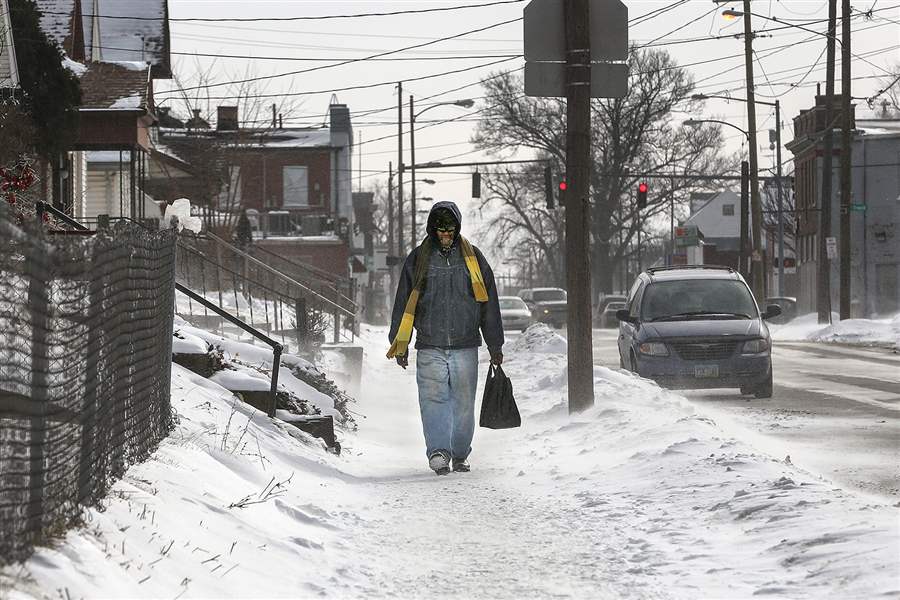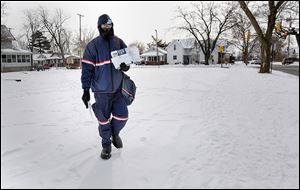
Twin arctic blasts on tap for Toledo area
Several inches of snow to come
1/25/2014
East Toledo resident Casey Payne braves the cold weather on his way back home from the grocery store. Temperatures in the Toledo area dropped to the low teens Friday with blowing snow limiting visibility.
THE BLADE/KATIE RAUSCH
Buy This Image

East Toledo resident Casey Payne braves the cold weather on his way back home from the grocery store. Temperatures in the Toledo area dropped to the low teens Friday with blowing snow limiting visibility.
Toledo’s nastiest winter in decades renewed its fury Friday afternoon with blustery winds that were expected to be followed by the first of two fresh blasts of snow during the course of the weekend.
Blowing snow from previous storms reduced visibility and built new drifts on Toledo-area highways Friday afternoon, and railroad operations were snarled by snow that blew into track switches and then froze. Most, but not all, Toledo-area school districts canceled classes yet again because of the weather.
The new snow started in northwest Ohio late Friday, with the National Weather Service forecasting 1 to 3 inches overnight and 1 to 2 inches more during the day today. Temperatures today were expected to start in the upper teens but drop below 10 by late afternoon, with wind chills below zero all day.
PHOTO GALLERY: Biting cold continues.
RELATED ARTICLE: Schools push limit of calamity days
RELATED ARTICLE: Drivers awaiting tow face woe of wait
Frank Kieltyka, a meteorologist at the National Weather Service office in Cleveland, said that after a brief respite late today, a second snowmaker is expected to drop another 2 to 3 inches — “it could go up to 4” — in northwest Ohio on Sunday.
“There will be some wind with that one too so some more blowing and drifting,” Mr. Kieltyka said.
And following that storm, forecasters said the Toledo area would fall into another deep freeze, with daily high temperatures only in the high single digits Monday through Wednesday with below-zero lows at night.

Postal worker Jemael Smith trudges through his rounds in South Toledo. He said, ‘It’s cold but there’s not much you can do about it.’ He advised to bundle up and minimize the skin showing to avoid frostbite.
Several rural counties issued weather warnings Friday, with Seneca County declaring a Level 2 advisory against all discretionary travel and Fulton County announcing a Level 1 alert for caution, both about 6:30 p.m., because of blowing and drifting snow.
Amtrak’s Lake Shore Limited train from New York to Chicago, which was canceled on consecutive days after Toledo’s 13-inch snowstorm earlier this month, limped into Toledo on Friday evening more than 14 hours late, which Amtrak blamed on weather-related problems across its route. The train took 5 hours and 45 minutes just to travel from Cleveland to Toledo, a trip scheduled for 2 hours, 10 minutes.
Its passengers were to board buses to Chicago so the equipment could be cleaned and restocked to return east as Friday night’s Chicago-New York departure, for which buses also were to be substituted west of Toledo.
New snow that fell at Toledo Express Airport overnight would only add to the January snowfall record that Toledo broke earlier in the week.
As of Friday afternoon, 32.8 inches had fallen at the airport so far this month, 2 inches more than the previous record from 1978.
The season total stood at 44.5 inches, or nearly 7 inches more than the 37.6 inches that falls in Toledo during an entire average winter.
The storms predicted today and Sunday are both known to meteorologists as Alberta Clippers, so named because they form over Alberta in western Canada and move quickly across North America, often tracking southwest across the Great Lakes region.
Alberta Clippers rarely deliver more than a few inches to the Toledo area, but occasionally they intensify rapidly upon reaching the Atlantic Ocean and become major storms in the Northeast and Maritime Canada.
Except for a few hours Monday morning, the thermometer at Toledo Express Airport has been below freezing since Jan. 15, and it is expected to rise no higher than the low 20s through at least Friday. Some forecasts Friday showed the region’s sub-freezing chill persisting past the first week of February.
David Call, a severe-weather expert at Ball State University in Muncie, Ind., said the region’s recent weather pattern has consistently featured a warm high-pressure flow in the western United States and a “trough” of cold air in the East. The jet stream, a high-altitude, high-speed wind that separates warm air from cold, has been pushed far north into western Canada while diving deep into the southeastern states.
“While we have been cold and snowy, the western U.S. — especially California — has been hot and dry,” Mr. Call said. “California gets most of its snow and rain in winter, so there could be serious water restrictions and a horrific fire season later this year if the weather pattern does not change soon.”
Warmth in western states also lays waste to any attempt to claim that the East’s frigid conditions represent denial of global warming, Mr. Call said.
“While we are experiencing colder than average conditions, places such as California and Australia are much warmer than average,” he said. “Global warming refers to a change in climate, which is the long-term average of weather … [and] does not mean an end to cold weather. It simply means that the cold weather would be a little less cold.”
Contact David Patch at: dpatch@theblade.com or 419-724-6094.